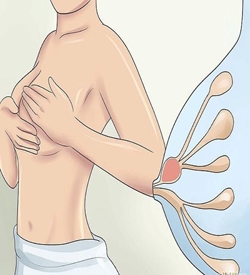Have you heard of milk blisters?
 A milk blister, or blocked pore within the nipple, is simply “milk trapped under the skin.” It can occur when a tiny bit of skin overgrows a milk duct opening and milk backs up behind it. They are often very painful, persistent and can reoccur easily. They show up as a white or clear blister on the nipple or areola.
A milk blister, or blocked pore within the nipple, is simply “milk trapped under the skin.” It can occur when a tiny bit of skin overgrows a milk duct opening and milk backs up behind it. They are often very painful, persistent and can reoccur easily. They show up as a white or clear blister on the nipple or areola.
Common causes of Milk Blisters are due to oversupply or engorgement. Milk blisters are thought to be caused by milk within a milk duct that has been sealed over by the epidermis and has triggered an inflammatory response.”
This should not be confused with a blister caused from poor attachment. These tend to be more yellow in colour and caused by the friction of sucking with a shallow latch or the constant rubbing of the nipple on their hard palate. This also is painful but is treated in a different way.
White spots on the nipple and/or inside your baby’s mouth can normally be associated with thrush. Again, this is treated differently and you should consult your GP for a script that can be safely used whilst breastfeeding. It can however be the cause of getting a milk blister.
Treatment
Apply a warm cloth that has been dipped in salty (Epson salts) water, just prior to feeding. Re-apply as it cools 3-5 times. You will need to repeat this for several days until you feel the blocked duct becomes clear. Dilution: 2 teaspoons Epson salts to one cup warm water.
Another option is to apply warm coconut oil which will soften the skin and assist in the healing. Any loose skin can gently be removed, taking care not to make further damage.
Always apply a small amount of expressed milk onto the nipple just prior to baby latching as to help soften and reduce friction pain. Again, repeat this after feeding is complete, aim to air dry your nipple before putting your bra back on.
If it is too painful to feed, you may need to look at using an electric breast pump to express or a nipple shield to create a barrier. Both of these I recommend you seek advice from a certified lactation consultant.
I do not recommend you pop the blister yourself for you will increase the risk of further infection. You should consider seeing your GP if it persists. Make sure you contact your doctor if you experience fevers, continued inflammation, or symptoms of Mastitis.
Written by: Alison Gregory Endorsed Midwife, Parenting Educator, Sleep and Lactation Consultant.
Photo by kevin liang on Unsplash

